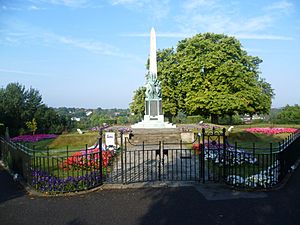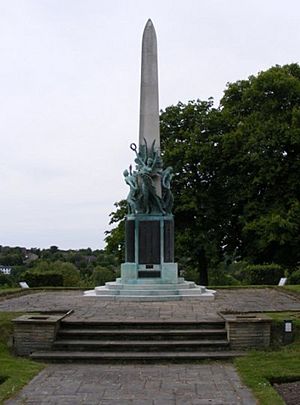Bromley War Memorial facts for kids

Bromley War Memorial
|
|
| Coordinates | 51°24′17.7″N 00°00′39.9″E / 51.404917°N 0.011083°E |
|---|---|
| Location | Bromley, Greater London, England |
| Designer | Sydney March |
| Type | obelisk |
| Material | Bronze and Portland Stone |
| Completion date | 1922 |
| Opening date | 1922 |
| Dedicated to | Fallen of World War I and World War II |
The Bromley War Memorial is a special monument in Bromley, Greater London, England. It was built to remember the brave people who died in World War I and World War II. A British artist named Sydney March designed this important memorial.
Contents
Where is the Memorial Located?
The Bromley War Memorial stands on Martin's Hill. This spot is close to where Glassmill Lane and Church Road meet in Bromley. The memorial is in a lovely garden, surrounded by iron railings.
It is placed right at the entrance of Martin's Hill. This was Bromley's very first park designed for beauty. Martin's Hill was likely named after a baker who used to live there. For many years, people from Bromley enjoyed walking on this hill. In the late 1800s, Martin's Hill offered amazing views of the Crystal Palace in Hyde Park, London.
Bromley itself got its name from the broom plant. This plant has bright yellow flowers and once grew everywhere in the area. In the 1800s, Martin's Hill was one of the last places where you could still see these flowering broom plants. In 1878, the Bromley Council bought the land. They planted trees and flowers, turning it into the beautiful park we see today.
What Does the Memorial Look Like?
The monument has a tall, square obelisk. An obelisk is a pillar with four sides that gets narrower at the top. This one is made from Portland stone. This stone is a type of limestone found on the Isle of Portland in the English Channel. The obelisk sits on a base with three steps.
Around the bottom of the obelisk, there are three bronze statues. On the back of the monument, there is a bronze cartouche. This is like a fancy carved plaque. Also, bronze plaques with the names of the fallen are placed on all four sides of the base.
The main statue in the middle is a winged figure called Victory. She holds a laurel wreath, which is a symbol of triumph. On either side of Victory, there are two more bronze figures. One is Liberty, holding a torch. The other is Peace, holding flowers that remind us of remembrance.
The memorial lists the names of 769 soldiers from the area who died in World War I. It also includes the names of 476 soldiers and regular people who were killed during World War II. The sculptor finished the memorial in 1922.
When Was it Dedicated?
The Bromley War Memorial was officially shown to the public on October 29, 1922. Lord Henry Horne, 1st Baron Horne unveiled it. He was a general during World War I. The Bishop of Rochester, John Reginald Harmer, then dedicated the monument. He was an Anglican bishop.
The plaques for those who died in World War II were dedicated later. This happened on November 6, 1949, which was Remembrance Sunday. Remembrance Sunday is always the second Sunday in November. It is the Sunday closest to Armistice Day (November 11). The Vicar of Bromley, Rev. W. H. Murray-Walton, led this dedication. He said that the memorial, first for World War I, had also become a symbol of remembrance for those killed in World War II. Important people like the mayor, Alderman B. J. Finnie, and Harold Macmillan, the local Parliament member, were there.
National Heritage List for England
The Bromley War Memorial was added to the National Heritage List for England on December 14, 1995. This list is the official record of all important historical places in England. English Heritage manages it.
The war memorial is listed as a Grade II* structure. This means it is very important and has "more than special interest." Only about 5.5% of listed buildings are Grade II*. Most are Grade II.
Who Designed the Memorial?
The Bromley War Memorial was designed and created by the British artist Sydney March. He was born in 1876 in Stoneferry, a part of Hull, England. Sydney was one of nine children, and eight of them became artists!
As a child, Sydney March worked as an apprentice for a sculptor who made monuments. Later, he studied at the Royal Academy Schools. He even won first prize there in 1900. March showed his art many times at the Royal Academy's annual exhibitions between 1906 and 1932. His family set up their art studios at their home in Farnborough, Kent, in 1902.
Sydney March was a very busy artist. He mostly focused on war memorials. He also created sculptures of British royalty and other famous people of his time. He and his brothers and sisters finished the National War Memorial of Canada. They did this after their brother, Vernon March, who was also a sculptor, passed away in 1930.
Other famous works by Sydney March include the Royal Inniskilling Fusiliers South African War Memorial in Northern Ireland. He also created the United Empire Loyalist Monument in Canada and the Lancaster Monument in England. He also made smaller sculptures, like busts (head and shoulders statues) of King Edward VII and Cecil Rhodes. These are now in the National Portrait Gallery, London in London.
Sydney March lived a long life and died in 1968 at age 92. His ashes were buried in his family's plot at Saint Giles the Abbot Churchyard in Farnborough. In 1922, Sydney had sculpted the bronze angel monument that marks the March family's burial spot.
Images for kids









